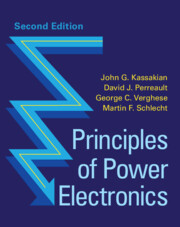Book contents
- Principles of Power Electronics
- Reviews
- Principles of Power Electronics
- Copyright page
- Dedication
- Contents
- Preface
- Acknowledgments
- 1 Introduction
- Part I Form and Function
- Part II Dynamic Models and Control
- Part III Components and Devices
- 15 Components and Devices: An Overview
- 16 Review of Semiconductor Devices
- 17 Power Semiconductor Devices
- 18 Introduction to Magnetics
- 19 Magnetic Component Modeling
- 20 Introduction to Magnetics Design
- 21 Magnetics Loss Analysis and Design
- Part IV Practical Considerations
- Index
- References
20 - Introduction to Magnetics Design
from Part III - Components and Devices
Published online by Cambridge University Press: 03 August 2023
- Principles of Power Electronics
- Reviews
- Principles of Power Electronics
- Copyright page
- Dedication
- Contents
- Preface
- Acknowledgments
- 1 Introduction
- Part I Form and Function
- Part II Dynamic Models and Control
- Part III Components and Devices
- 15 Components and Devices: An Overview
- 16 Review of Semiconductor Devices
- 17 Power Semiconductor Devices
- 18 Introduction to Magnetics
- 19 Magnetic Component Modeling
- 20 Introduction to Magnetics Design
- 21 Magnetics Loss Analysis and Design
- Part IV Practical Considerations
- Index
- References
Summary
The previous chapters on magnetics provided thekey concepts needed to analyze, model, and designmagnetic components such as inductors andtransformers. The purpose of this chapter is torefine and extend the methods introduced there,with a focus on techniques for magnetic componentdesign. In particular, we introduce design methodsand sizing considerations for efficientlyconverging on an appropriate design. Thisincludes, for example, approximate methods forsizing the magnetic core for an inductor ortransformer, and metrics for comparing magneticmaterials.
Information
- Type
- Chapter
- Information
- Principles of Power Electronics , pp. 612 - 642Publisher: Cambridge University PressPrint publication year: 2023
